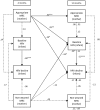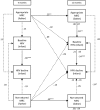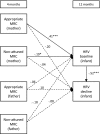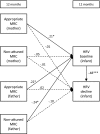Mothers' and fathers' mind-mindedness influences physiological emotion regulation of infants across the first year of life
- PMID: 29920863
- PMCID: PMC6220880
- DOI: 10.1111/desc.12689
Mothers' and fathers' mind-mindedness influences physiological emotion regulation of infants across the first year of life
Abstract
The main aim of this study was to test whether mothers' (n = 116) and fathers' (n = 116) mind-mindedness predicts infants' physiological emotion regulation (heart rate variability; HRV) across the first year of life. Three hypotheses were examined: (a) parents' mind-mindedness at 4 and 12 months predicts infants' HRV at 12 months over and above infants' initial HRV levels at 4 months, (b) mothers' and fathers' mind-mindedness independently predict infant HRV, and (c) the effects of mind-mindedness on infant HRV (partially) operate via parenting behaviour. Infants' HRV was assessed during rest and a stranger approach. Mind-mindedness was assessed by calculating the proportions of appropriate and non-attuned mind-related comments during free-play interactions, and parenting quality was observed at 4 and 12 months in the same interactions. Path analyses showed that mothers' appropriate mind-related comments at 4 and 12 months predicted higher baseline HRV at 12 months, whereas mothers' non-attuned comments predicted lower baseline HRV at 12 months. Similar, but concurrent, relations were found for fathers' appropriate and non-attuned mind-related comments and infant baseline HRV at 12 months. In addition, fathers' appropriate mind-related comments showed an indirect association with infant baseline HRV at 12 months via fathers' parenting quality. With regard to infant HRV reactivity during the stranger approach, mothers' appropriate mind-related comments at 4 months and fathers' non-attuned mind-related comments at 12 months predicted a larger HRV decline during the stranger approach at 12 months. Infants' HRV at 4 months did not predict parents' later mind-mindedness. The results indicate that mothers' and fathers' appropriate and non-attuned mind-related speech uniquely impacts the development of infants' physiological emotion regulation.
© 2018 The Authors. Developmental Science Published by John Wiley & Sons Ltd.
Figures






Similar articles
-
Long-term sequelae of mothers' and fathers' mind-mindedness in infancy: A developmental path to children's attachment at age 10.Dev Psychol. 2019 Apr;55(4):675-686. doi: 10.1037/dev0000660. Epub 2018 Dec 10. Dev Psychol. 2019. PMID: 30525830 Free PMC article.
-
Parent mind-mindedness, sensitivity, and infant affect: Implications for attachment with mothers and fathers.Infant Behav Dev. 2019 Nov;57:101330. doi: 10.1016/j.infbeh.2019.101330. Epub 2019 Jun 20. Infant Behav Dev. 2019. PMID: 31228665 Free PMC article.
-
Maternal mind-mindedness over infants' first three months.Infant Behav Dev. 2023 Aug;72:101864. doi: 10.1016/j.infbeh.2023.101864. Epub 2023 Jul 16. Infant Behav Dev. 2023. PMID: 37454575
-
Quality of life among parents of preterm infants: a scoping review.Qual Life Res. 2018 May;27(5):1119-1131. doi: 10.1007/s11136-017-1771-6. Epub 2017 Dec 16. Qual Life Res. 2018. PMID: 29248997
-
Sleep, mental health and wellbeing among fathers of infants up to one year postpartum: A scoping review.Midwifery. 2020 Sep;88:102738. doi: 10.1016/j.midw.2020.102738. Epub 2020 May 20. Midwifery. 2020. PMID: 32521406
Cited by
-
A longitudinal study on the relation between parenting and Toddler's disruptive behavior: what is the role of Toddler's negative emotionality and physiological stress reactivity?Front Psychol. 2024 Sep 9;15:1444447. doi: 10.3389/fpsyg.2024.1444447. eCollection 2024. Front Psychol. 2024. PMID: 39315044 Free PMC article.
-
Nature-Based Relaxation Videos and Their Effect on Heart Rate Variability.Front Psychol. 2022 Jun 10;13:866682. doi: 10.3389/fpsyg.2022.866682. eCollection 2022. Front Psychol. 2022. PMID: 35756241 Free PMC article.
-
Exploring Associations Between Infant Attachment, Maternal Sensitivity, and Attention to Maternal Emotion Expressions.Dev Sci. 2025 Sep;28(5):e70057. doi: 10.1111/desc.70057. Dev Sci. 2025. PMID: 40741767 Free PMC article.
-
Stressed Mothers Receiving Infant Mental Health-Based Early Head Start Increase in Mind-Mindedness.Front Psychol. 2022 Jun 1;13:897881. doi: 10.3389/fpsyg.2022.897881. eCollection 2022. Front Psychol. 2022. PMID: 35719560 Free PMC article.
-
Methods for analyzing infant heart rate variability: A preliminary study.Birth Defects Res. 2023 Jun 1;115(10):998-1006. doi: 10.1002/bdr2.2177. Epub 2023 Apr 20. Birth Defects Res. 2023. PMID: 37078641 Free PMC article.
References
-
- Ainsworth, M.D.S. , Bell, S.M. , & Stayton, D.J. (1974). Infant–mother attachment and social development: Socialisation as a product of reciprocal responsiveness to signals In Richards M.P.M. (Ed.), The introduction of the child into a social world (pp. 99–135). Cambridge: Cambridge University Press.
-
- Appelhans, B.M. , & Luecken, L.J. (2006). Heart rate variability as an index of regulated emotional responding. Review of General Psychology, 10, 229–240.
-
- Arnott, B. , & Meins, E. (2007). Links among antenatal attachment representations, postnatal mind‐mindedness, and infant attachment security: A preliminary study of mothers and fathers. Bulletin of the Menninger Clinic, 71, 132–149. - PubMed
-
- Bar‐Haim, Y. , Marshall, P.J. , & Fox, N.A. (2000). Developmental changes in heart period and high‐frequency heart period variability from 4 months to 4 years of age. Developmental Psychobiology, 37, 44–56. - PubMed
-
- Bates, E. (2014). The emergence of symbols: Cognition and communication in infancy. New York: Academic Press.
MeSH terms
LinkOut - more resources
Full Text Sources
Other Literature Sources

